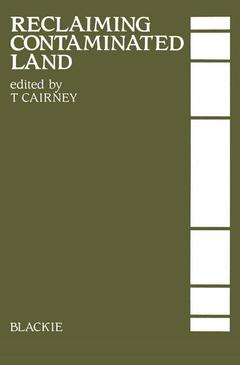1 Recognition of the problem.- 1.1 Introduction.- 1.1.1 What is contaminated land.- 1.1.2 Where does it occur.- 1.1.3 How common is it.- 1.1.4 How is it managed.- 1.2 National response to contaminated land in the UK.- 1.2.1 Central government respons.- 1.2.2 Local government response.- 1.3 National response to contaminated land in Europe and North America.- 1.3.1 Introduction.- 1.3.2 The Netherlands.- 1.3.3 Federal Republic of Germany.- 1.3.4 The United States of America.- References.- 2 Types of contaminated land.- 2.1 Introduction.- 2.2 Transportation of contamination.- 2.2.1 Atmospheric fallout.- 2.2.2 Contamination by liquids.- 2.2.3 Contamination by solid waste disposal.- 2.3 Main sources of land contamination.- 2.3.1 Non-ferrous metal mining and processing sites.- 2.3.2 Sewage works and farms.- 2.3.3 Scrapyards.- 2.3.4 Railway land.- 2.3.5 Iron and steelworks sites.- 2.3.6 Dyeworks.- 2.3.7 Coal carbonization on gasworks sites.- 2.3.8 Coal-fired power stations.- 2.3.9 Landfill sites.- 2.3.10 Pharmaceutical manufacturing sites.- 2.3.11 Tanning and fellmongering.- 2.4 Conclusions.- References.- 3 Main types of contaminants.- 3.1 Introduction.- 3.2 Metallic contaminants.- 3.2.1 Arsenic.- 3.2.2 Cadmium.- 3.2.3 Lead.- 3.2.4 Copper, nickel and zinc.- 3.3 Inorganic contaminants.- 3.3.1 Cyanides.- 3.3.2 Sulphates.- 3.4 Organic contaminants.- 3.4.1 Phenols.- 3.4.2 Coal tars.- 3.5 Asbestos.- 3.6 Combustible materials.- 3.7 Gases.- 3.8 Other contaminants.- References.- 4 Appropriate site investigations.- 4.1 Introduction.- 4.2 Recognition that an investigation is needed and establishment of the basis for that investigation.- 4.2.1 Recognition.- 4.2.2 Prospective surveys.- 4.2.3 Site specific prospective surveys.- 4.2.4 Site reconnaissance.- 4.3 Design of site sampling/analytical programme.- 4.3.1 The hazard associated with contaminants.- 4.3.2’ sensitivity’ of site use.- 4.3.3 Multi-disciplinary approach.- 4.3.4 The aim of sampling/analysis.- 4.3.5 Sampling patterns and sample numbers.- 4.3.6 Sampling depth.- 4.3.7 Sampling quality assurance.- 4.3.8 Sampling stages.- 4.4 On-site sampling, observation and testing.- 4.4.1 Safety.- 4.4.2 Excavation methods.- 4.4.3 Sampling methods.- 4.4.4 On-site testing.- 4.5 Analysis of material taken from the site.- 4.5.1 Sub-sampling in the laboratory.- 4.5.2 Selection of analytical methods.- 4.5.3 Analytical quality assurance.- 4.5.4 Recommended analytical methods.- 4.6 Interpretation of analytical data.- 4.6.1 General interpretation requirements.- 4.6.2 ‘Background’ and ‘typical’ levels.- 4.6.3 Guideline levels.- 4.6.4 Mathematical methods of assessing data.- References.- 5 Available reclamation methods.- 5.1 Introduction.- 5.2 The land use option.- 5.3 General considerations.- 5.3.1 The ‘typical’ site.- 5.3.2 Defining the objectives of a reclamation scheme.- 5.3.3 The Building Regulations: The ‘approved document’ on contaminants.- 5.3.4 Long-term effectiveness of remedial measures.- 5.4 The options.- 5.5 Excavation.- 5.6 Soil treatment after excavation.- 5.6.1 Introduction.- 5.6.2 Extraction and separation techniques.- 5.6.3 Thermal methods.- 5.6.4 Chemical treatment methods.- 5.6.5 Microbial treatment methods.- 5.6.6 Stabilization/solidification processes.- 5.7 In-situ treatment.- 5.8 Macro-encapsulation/isolation.- 5.8.1 Introduction.- 5.8.2 Vertical barrier systems.- 5.8.3 Horizontal in-ground barriers.- 5.8.4 Controlling infiltration.- 5.9 Covering systems.- 5.10 Execution of reclamation works.- 5.11 Monitoring and evaluation of performance.- 5.12 Guidance available.- References.- 6 Soil cover reclamations.- 6.1 Introduction.- 6.2 Performance requirements for soil cover reclamations.- 6.3 The contaminant problem.- 6.4 Pathways for contaminant migration.- 6.5 Groundwater and soil moisture movements.- 6.5.1 Introduction.- 6.5.2 Groundwater cyclic movements.- 6.5.3 The capillary rise of polluted soil moisture.- 6.6 Choice of soil cover materials.- 6.7 The design of soil cover reclamations.- 6.7.1 Introduction.- 6.7.2 Gasworks site, NE England.- 6.7.3 North London gasworks site.- 6.7.4 Tar works site, S.W. England.- 6.7.5 Waste disposal tip, N.E. England.- 6.8 Summary.- References.- 7 Long-term monitoring of reclaimed sites.- 7.1. Introduction.- 7.2 Established precedents for monitoring.- 7.2.1 A comparison of the reclamation and civil engineering industries.- 7.2.2 Monitoring, maintenance and ‘factor of safety’.- 7.3 Questions on the long-term effectiveness of reclamation options.- 7.4 Monitoring systems and methods.- 7.4.1 Periodic site inspections.- 7.4.2 Periodic water quality analyses.- 7.4.3 Periodic groundwater quality monitoring.- 7.4.4 Routine site temperature recording.- 7.4.5 Routine gas monitoring.- 7.4.6 Site drainage efficiency monitoring.- 7.4.7 Soil cover monitoring.- 7.4.8 Monitoring for specific contaminants.- 7.4.9 General points.- 7.5 Organization control of monitoring.- 7.6 Summary.- References.- 8 Safety in site reclamation.- 8.1 Introduction.- 8.2 Nature of hazards.- 8.2.1 Introduction.- 8.2.2 Solids.- 8.2.3 Liquids.- 8.2.4 Gases.- 8.2.5 Asbestos.- 8.3 Protection against hazards.- 8.3.1 Introduction.- 8.3.2 Clothing.- 8.3.3 Personal hygiene.- 8.3.4 Hazard monitoring.- 8.3.5 Safety equipment.- 8.3.6 First aid.- 8.3.7 Equipment storage and maintenance.- 8.4 Safety procedures.- 8.4.1 Introduction.- 8.4.2 Contract powers.- 8.4.3 Environmental safety officer.- 8.4.4 Site training.- 8.4.5 Safe working procedures.- 8.4.6 Excavation works in restricted areas.- 8.4.7 Abatement or removal of hazards.- 8.4.8 Emergency procedures.- 8.5 Conclusions.- 8.6 Appendix: environmental health and safety guide for construction site staff (an example).- 8.6.1 Introduction.- 8.6.2 Safe working procedures.- 8.6.3 Form of chemical hazards.- References.- 9 Policy, planning and financial issues.- 9.1 Introduction.- 9.2 Controlling the development of contaminated land.- 9.3 Land-use planning and control.- 9.3.1 Forward planning.- 9.3.2 Development control.- 9.3.3 Building regulations.- 9.4 Public health legislation and development control.- 9.5 Financial resources.- 9.5.1 Derelict land grant scheme.- 9.5.2 Works eligible for finance.- 9.5.3 Urban development grant.- References.- 10 Landscaping and vegetating reclaimed sites.- 10.1 Introduction.- 10.2 Requirements of plants.- 10.3 Physical support for plants.- 10.4 Compaction.- 10.5 Water supply and storage.- 10.6 Plant nutrients.- 10.7 Grassland establishment.- 10.8 Grass seed mixtures.- 10.9 Grass cutting.- 10.10 Wild species.- 10.11 Trees and shrubs.- 10.12 Timing.- 10.13 Plant and soil interactions.- 10.14 Conclusions.- References.- 11 Hazards from methane (and carbon dioxide).- 11.1 Introduction.- 11.2 Relevant gases and their principal characteristics.- 11.2.1 Introduction.- 11.2.2 Typical landfill gas composition.- 11.2.3 Landfill gas generation—principal factors.- 11.3 Gas flow in and from landfill sites.- 11.3.1 Introduction.- 11.3.2 Buoyancy effects.- 11.3.3 Gas concentrations.- 11.3.4 Effects of water table.- 11.4 Gas measurement.- 11.4.1 Introduction.- 11.4.2 Gases to be tested.- 11.4.3 Sampling and monitoring systems.- 11.4.4 Taking gas measurements.- 11.4.5 Interpreting gas measurements.- 11.5 Gas control measures.- 11.5.1 Introduction.- 11.5.2 Options for reducing hazards to buildings.- 11.5.3 Migration barriers.- 11.5.4 Vent trenches.- 11.5.5 Ground engineering factors.- 11.5.6 Pumping.- 11.6 Hazards in buildings.- 11.6.1 Introduction.- 11.6.2 Explosions.- 11.6.3 Gas mixing and layering.- 11.6.4 Acceptable size of gas accumulations.- 11.7 Effects on plants.- 11.7.1 Introduction.- 11.7.2 Potential toxic mechanisms.- Acknowledgement.- References.




